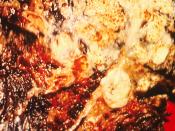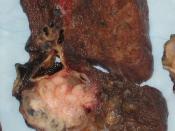Almost everyone has been affected by cancer whether it was themselves, a family member, or a friend. Many of those people have seen the destruction it does to the victim and their family and friends. After years of research and many attempts to find the cure we are nearly there; new therapies are coming through, and the cure for cancer should be out in the next fifty years.
Cancer affects millions of people each year, but what is it? Before we can ponder that question we will need to know how regular cells reproduce. Nonmutated cells reproduce by splitting in half then rapidly growing back to normal size. They reproduce at exactly the same rate at which they die, therefore a person always has the same number of cells. This cycle is constantly going on, it is only changed when a person is growing or has damaged the skin. These examples both show cells reproducing faster than they die.
When a cell reproduces faster than the death rate, and there is no other need to grow, the cell is cancerous (Rauscher 135-136).
We now know what cancer is, but how do we get it? There are many different variables that contribute to cancer. Ultraviolet light is the radiation that comes from the sun. It causes us to have a tan, but it is also causes melanoma and skin cancer. The human skin is the first line of defense for many diseases and skin cancer is no different. The skin is designed to tolerate quite a bit of ultraviolet radiation but at high enough frequency there is no defense. Everyday we are exposed to some kind of radiation whether it is radio waves, infrared rays (heat), or just visible light but only ultraviolet rays, x-rays, and gamma rays cause cancer in...


